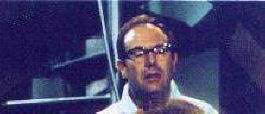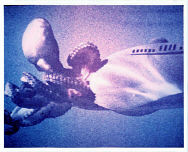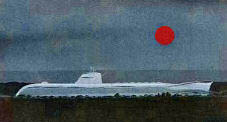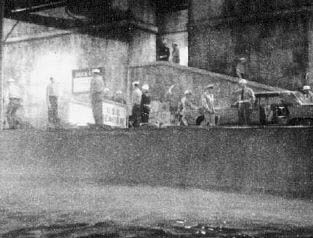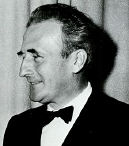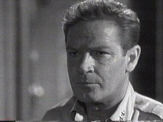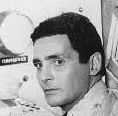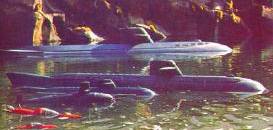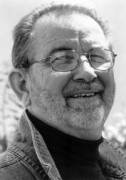|
The following was internally generated by 20 th Century Fox back in the late 60s (with the exception of minor editing on my part--Mike Bailey). VOYAGE TO THE BOTTOM OF
THE SEA "Voyage" has been a preoccupation with Allen for five years, from the time he first began researching an original story about a submarine of the future, set in ("Let's say the late 1960s or early 1970's" says Allen).* This grew to be the fantastically successful motion picture, Voyage to the Bottom of the Sea, a blockbuster for 20th Century-Fox in 1961.
"For example" Allen points out, "the three main underwater sections of our Seaview submarine cost more than $400,000 to build more than most television pilot films in their entirety. Yet, when we were ready to make the television pilot, we had at our disposal, and in perfect working order, the intact sections of the control room, the viewing room (the only submarine with a glass nose**) and the missile/torpedo room fully equipped with more than two-dozen of the latest atomic warhead-carrying missiles. Carrying the value them a step further, Allen points out that his production assistant, Paul Zastupnevich originally designed a complete wardrobe of uniforms ranging from the mess clerk to the Admiral himself. "We had to have a military appearance," Allen states, "yet we could not duplicate any existing uniform of any army or navy in the world. In addition, we had to take into account the ever changing modes and modernization of military uniforms. I think Paul (Zastupnevich) dreamed up our Department of Marine Science uniforms one day while rotating his thoughts between World War II and a space trip of the future.
The production values cannot be overstressed. For example, Allen is one of a handful of Hollywood producer-directors who has every piece of action sketched first and then has his players follow through in front of the cameras. For "Eleven Days to Zero," the initial TV "Voyage" of the Seaview, Allen had Maurice Zuberano, Hollywood's top production illustrator, prepare 1,100 sketches, but again, his past familiarity with the project made this a much simpler task than it might otherwise have been. The Seaview itself is some 600 feet long (the length of two football fields laid end to end) and the majority of the action takes place in the three aforementioned rooms. Its home base is at the Nelson Institute of Marine Research, a private scientific bureau under the direction of brilliant Admiral/scientist, Admiral Harriman Nelson, USN (Ret.).
Irwin Allen was indeed fortunate in securing the services of Oscar-winning cinematographer Winton Hoch as his cameraman on the filming of Voyage, for Hoch is as familiar with the Seaview as Allen
Hoch, a pioneer in the field of trick photography,
lighting techniques, painting with the camera, miniature photography and
rear screen projection, teamed with 20th Century-Fox Photographic Effects chief
Bill (L.B.) Abbott in creating the fantastic visual effects for Voyage
including simulated scenes of the Seaview racing underwater at 70-plus
knots. L.B.
Abbott Abbott is a 20-year veteran of the Fox photo effects
department with an Oscar nomination for "Journey to the Center of the
Earth" and such credits as "Cleopatra," "The Enemy Below" and previous
Irwin Allen movies. In addition, Abbott won the 1965 Emmy for Special
Photographic Effects for his work on VOYAGE TO THE BOTTOM OF THE SEA and
later for THE TIME TUNNEL. "Here again," Allen says, "the footage on underwater scenes which we had literally by the thousands of feet, would have been virtually impossible to duplicate within the budget of any television series." All the production values in the world won't mean much unless you have the people to carry out the action, and Allen feels confident that he has a cast that not only will be acceptable to the viewing public, but one which will rate with the top adventure stars on the air.
But his seriousness stoops as soon as he's off camera and on the set. During the filming of the VOYAGE pilot, Basehart entertained the extras and technicians by reciting Shakespeare in both English and Italian.
David Hedison
If the stress seems to be on visual and mechanical effects, there is a reason, for Voyage is truly an adventure-packed hour in which the audience really lives and feels the excitement and drama of the action aboard an atomic submarine of the future. * In fact, early in the series, the chronological setting was 1973, but it was moved up to 1980 and then 1983 in later seasons. .** It was Theodore Sturgeon in the Voyage movie novelization that came up with the detail that the observation windows/ports were made out of herculite. No glass in or out of existence could withstand the pressures which Seaview's missions would subject them to. *** One assumes this statement refers pretty much to the first two seasons only. **** Please note that David Hedison's version of how his involvement in Voyage came about is considerably different than this studio version.
|
|
